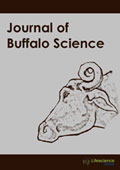jbs
Editor’s Choice : Growth Traits of Anatolian and Anatolian x Italian Crossbred Buffalo Calves Under the Village Conditions
|
|
Abstract: The study was carried out to compare growth performances of Anatolian and crossbred (Anatolian x Italian) buffalo calves (53 F1, 66 Anatolian, 26 F1xAnatolian) raised at Ilıkpınar Village of Kırıkhan District of Hatay Province. Body measurements were determined in the period of 0-12 months of age. The effects of genotype, sex, birth year effects on each characteristic in each age were investigated using GLM variance analysis. The means of each characteristic in each age for each genotype were calculated. Duncan test was used in comparison of the averages of each characteristic SPSS program was used in the statistical procedures. Genotype created significant variation in live weight at 1 and 6 months of ages respectively and on almost every body measurement almost in every age. Genotype* birth weight, genotype*sex, and genotype*birth year* sex interactions were found statistically significant in the point of view of various characteristics in various ages. Factors had significant effects on various characteristics in various ages. It can be said that, F1 growth was the most speedly and Anatolian buffaloes stayed behind of the other genotypes from the point of view of all the traits. Keywords: Buffalo, Anatolian, Italian, Body measurements.Download Full Article |
Editor’s Choice : Effect of Saccharomyces cerevisiae Live Cellson In Vivo Digestibility and Nitrogen Excretion in Lactating Buffaloes
|
|
Abstract: The effects of dietary inclusion of Saccharomyces cerevisiae cultureon intake, in vivo digestibility, and fecal nitrogen excretion were examined in dairy buffalo. Forty lactating buffalo cows were equally divided into Control and Saccharomycesgroups, balanced for milk production, parity, and days in milk. Two subsequent 16-d experimental phases were carried out. For both groups during the first experimental period a TMR based on maize silage (maize-TMR) was used, whereas in the second period an alfalfa haylage (alfalfa-TMR) was administered to the animals. In each experimental period, Saccharomyces group was supplemented with 50 g/head/day of yeast (Biocell®, Limena, Padova, Italy), corresponding to 20×109 CFU/head/day Saccharomyces cerevisiae NCYC Sc47 strain. The yeast supplement was top-dressed onto the morning feed. Dry matter intake (DMI) was assessed for 6 consecutive d on group basis, by the difference between feed offered and refused. In the last 3 days of experimental period in vivo digestibility was determined by using acid-insoluble ash (AIA) as an intrinsic digestibility marker. Saccharomyces supplemented buffalo cows presented greater DMI of maize-TMR, whereas no statistical differences between the groups were observed for alfalfa-TMR. Saccharomyces supplementation significantly improved in vivo digestibility of both TMR. Fecal nitrogen excretion was significantly reduced by the use of yeast supplementation. Results suggest that the inclusion of Saccharomyces cerevisiae culture in the diet for lactating buffaloes can be recommended for its effects on cow’s digestive efficiency and fecal nitrogen excretion. Keywords: Buffalo cows, Yeast, Dry matter intake, Digestibility, Fecal nitrogen excretion.Download Full Article |
Editor’s Choice : Haematological and Biochemical Characterization of Bubaline Trypanosomosis in Mumbai Region of India
|
|
Abstract: The present study was based on observations on 17 cases of Trypanosoma evansi infection in buffaloes diagnosed by blood smear examination. The degree of parasitaemia revealed heavy (64.70%), moderate (23.52%) and mild (11.76%) infections in buffaloes.Haematological analysis revealed subnormal erythrocytic count and haemoglobin in 70.58% buffaloes. Leukocytosis was evident in 70.58% buffaloes with neutrophilia relatively associated with lymphocytopenia.Blood glucose level of 15 hypoglycaemic buffaloes ranged between 27 to 49.05 gm/dl with an average of 39.35 gm/dl. The comparative analysis of the degree of hypoglycaemia with parasitaemia revealed positive correlation between two parameters. Biochemical analysis of sera and blood samples showed increase level of BUN and serum creatinine in 17.64% buffaloes. Keywords: Trypanosoma evansi, Buffaloes, Haematology, Biochemistry. |
Editor’s Choice : Physiological Changes and Blood Flow in Murrah Buffaloes during Summer and Winter Season
|
|
Abstract: Present study was designed to investigate the changes in physiological reactions and blood flow during different seasons in Murrah buffaloes. Six Murrah buffalo heifers of 18-24 months were selected as experimental animals. The respiration rate (RR), heart rate (HR) and blood pressure was measured through BPL-Excello multi parameter monitor. Rectal temperatures were recorded with electronic thermometer. Skin surface temperatures at the different body sites were recorded using infrared thermometer (Metravi MT-2). The blood flow was measured on Perimed Multichannel Laser Doppler system using skin perfusion probe 408 at dorsal region, abdomen region and middle ear. Results showed a significant difference for respiration rate (P<0.001); rectal temperature (P<0.05) and heart rate (P<0.001) during summer and winter season. The mean blood pressure was 93.74/186.36 mmHg in summer and 97.40/198.08 mmHg in winter, respectively. In the present experiment, both diastolic and systolic pressure differed significantly (P<0.001) during different seasons. The mean skin surface temperature in summer was 37.03±0.39, 36.12±0.27 and 33.15±0.98°C at dorsal, abdomen and middle ear, respectively; whereas, during winter it was 29.87±0.69, 29.92±0.40 and 23.82±1.12°C at dorsal, abdomen and middle ear, respectively. The skin surface temperature among the different parts of the body differed significantly (P<0.001). During summer, the mean blood flow was 4.71±0.49, 14.85±1.63 and 16.72±1.47 PU; whereas, during winter, it was low, 1.10±0.16, 8.96±0.58 and 12.16±0.95 PU at dorsal, abdomen and middle ear, respectively. The difference in the blood flow among the different parts of the body differed significantly (P<0.001) in summer and winter. The results indicated that blood flow was positively correlated with temperature of the body parts and it varied in different seasons. This study concluded that, summer stress evokes a series of physiological changes in the Murrah buffalo’s, which affects productionduring summer season. Keywords: Blood flow, Murrah buffalo, Physiological responses, Summer, Winter. |






















